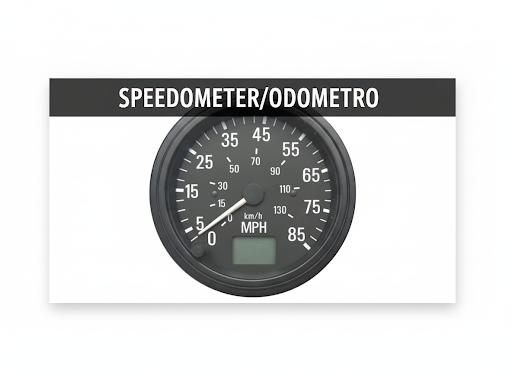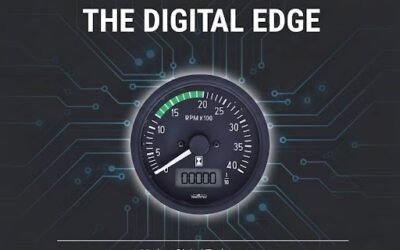
What is a speedometer and why is a speedometer so important?
A speedometer is an instrument that displays the instantaneous speed of a vehicle, or to be more precise, the vehicle’s wheels.
Speedometers inform the user about how fast the vehicle is traveling at any given point. This can be in kilometers per hour (km/h) or miles per hour (mph).
A speedometer is a very important instrument in any vehicle, since drivers are supposed to follow speed limits while driving, and so they need to know the vehicle speed accurately.
What is the accuracy of a speedometer, and is vehicle speed accuracy the same as speedometer accuracy?
A speedometer is always supposed to show a speed higher than the actual vehicle speed, to discourage the driver from going too fast. The accuracy on average is about ±2% of full scale, but this can vary depending on the design of the speedometer.
The vehicle speed accuracy depends on factors other than the speedometer itself. The wheel RPM is transmitted to the speedometer through gears and pulleys, and there may be small errors in these ratios compared to the theoretical calibration.
What is an Odometer and Trip Odometer?
An odometer, though often accompanying the speedometer, is a separate instrument that measures the total distance a vehicle has travelled. The reading is either in kilometers (km) or miles (mi).
A trip odometer measures distance travelled over a specific period or journey and can be reset at will by the driver — for instance, to track daily travel or distance per fuel tank.
Why are there two trip odometers in some vehicles?
This is an additional convenience feature, allowing the driver to track two separate trip distances — such as one for daily use and another for maintenance or business purposes.
Why is an odometer important?
The odometer records the total distance travelled by a vehicle — a critical parameter for warranty tracking, scheduled servicing, fuel efficiency calculations, and resale value.
Types of Speedometers & Odometers
- Mechanical Speedometers/Odometers: Use a flexible rotating cable connected to the gearbox, displaying speed via a pointer and distance via rotating number wheels.
- Electronic Speedometers/Odometers: Use sensors and electronic signals (analog or CAN-based) to drive digital or pointer displays, with data often shown on LCD screens.
Input Sources for Electronic Speedometers/Odometers
- Vehicle Speed Sensor (VSS)
- Wheel Speed Sensor (WSS)
- GPS Sensor
Inputs may be analog or digital (e.g., CAN/J1939) and can come from sensors directly or via an ECU.
Frequently Asked Questions (FAQ)
1. What distinguishes a speedometer from a tachometer?
A speedometer measures vehicle wheel RPM and converts it to speed (km/h or mph), whereas a tachometer measures engine RPM. The two values differ due to gearbox and differential ratios.
2. How Does an Electronic Speedometer/Odometer Work?
Electronic units use analog or digital pulses from sensors, filter them, and drive a stepper motor or display. Digital signals (e.g., J1939) require minimal filtering and are highly accurate.
3. Why do I see a speedometer used in tractors even though it is off-road equipment and regulations don’t apply to it?
Even though tractors and off-road vehicles are not bound by on-road speed regulations, speedometers are installed for operator convenience and safety. They help the driver maintain consistent speeds for tasks such as ploughing, seeding, or towing, where speed affects equipment performance and fuel efficiency.
Additionally, many modern tractors are designed for limited on-road transport between farms, where speed indication is helpful and often expected by users.
4. What is the advantage of Stepper Motor driven vs. Air-Core driven speedometers?
Stepper motors provide higher accuracy and self-test features, while air-core types offer quicker response and lower cost.
5. What are the advantages and disadvantages of a GPS speed sensor, a vehicle speed sensor, and a wheel speed sensor?
| Sensor Type | Advantages | Disadvantages |
|---|---|---|
| GPS Speed Sensor | Very accurate in open areas; unaffected by tire wear or gear ratio changes. | Signal can be lost in tunnels, dense forests, or indoors; slight delay due to satellite processing. |
| Vehicle Speed Sensor (VSS) | Reliable and compact; directly linked to gearbox or transmission. | Accuracy can vary if tire size or gear ratios are changed; mechanical wear possible. |
| Wheel Speed Sensor (WSS) | Provides precise, wheel-specific speed data; useful for ABS and traction control. | Can be affected by wheel slip or skidding; requires clean, dry conditions to avoid sensor fouling. |
6. What is the advantage and disadvantage of a pointer-based speedometer vs. a 7-segment display?
| Type | Advantages | Disadvantages |
|---|---|---|
| Pointer-based (Analog) | Easy to interpret at a glance; visually continuous; good for dynamic driving. | Less precise for exact readings; mechanical parts can wear over time. Parallax errors |
| 7-Segment (Digital) | Highly precise; easy to read in low light; modern aesthetic. No parallax errors | Can cause driver distraction due to rapid numerical changes; less intuitive for trends in acceleration/deceleration. |
7. What is the relationship between speed and distance?
Speed and distance are directly related through time.
Mathematically:
Distance = Speed × Time
If the vehicle maintains a constant speed, the odometer reading increases proportionally with time. Hence, the speedometer’s instantaneous readings and the odometer’s cumulative readings are linked by this relationship.
8. What is the disadvantage of giving power to the speed sensor through the speedometer?
If the speedometer supplies power to the speed sensor, any failure or disconnection of the speedometer will disable the sensor, causing both the speedometer and odometer to stop functioning. This also complicates diagnostics since both devices share a common failure point. Independent power supply ensures better reliability and easier troubleshooting.
9. How are the speedometer and odometer calibrated?
Speedometer Calibration Formula:
f=Np/km×V3600
Where:
- f = Input frequency (Hz) at a given speed
- Nₚ/km = Number of pulses per kilometer
- V = Vehicle speed (km/h)
For 60 km/h,
f60=Np/km60
Calculation of Pulses per Kilometer:
Np/km=W×Np/rev1000C
Where:
- W = Gear ratio between sensor and wheel
- Nₚ/rev = Sensor pulses per revolution
- C = Wheel circumference (meters)
Example: If W = 4, Nₚ/rev = 8, C = 2 m →
Np/km=4×8×10002=16,000 pulses/km
Odometer Calibration Formula:
Distance (km)=NpNp/km
For digital odometers incrementing every 0.1 km:
Increment Step=Np/km10
Example: If Nₚ/km = 16 000 → 1 600 pulses = 0.1 km increment.





